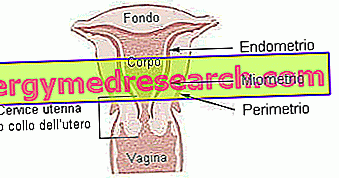Definition of adenomyosis
Glossary- Endometrium (endometrial tissue): mucosa that internally covers the uterus
- Myometrium: muscular layer of the uterine wall, between the perimeter (serous tunic of the uterus, its most external part) and endometrium
"Adenomyosis" is a purely medical term used to indicate a benign pathological condition in which a portion of endometrial tissue * develops along the muscular walls of the uterus. In simple words, adenomyosis occurs when the endometrium *, growing in places where it normally should not be, invades the myometrium *.
Also known with the term "internal endometriosis", adenomyosis must not be confused with endometriosis proper (external): in the latter case the endometrial tissue is located outside the uterus, thus growing in the pelvis ( eg in the ovaries, in the fallopian tubes, in the tract between the rectum and the uterus or in the ureter) or outside it (eg in the navel, in the lungs, in the vulva, etc.).


Despite not constituting a malignant lesion, in some women adenomyosis represents a real torment, such as to have negative repercussions on life habits: for this reason, pharmacological and / or surgical treatment (above all) is of primary importance.
Causes
The exact cause of adenomyosis remains an unresolved question. However, from the statistical analysis of some scientific works a certain correlation was observed between the onset of the disorder and some factors, such as in particular:
- Tubal ligation
- Voluntary interruption of pregnancy
- Caesarean section
- Multiple parts
- Surgery at the uterus (eg for removal of uterine / endometrial fibroids or polyps)
Some experts believe that in some women adenomyosis has a hereditary origin (presumably genetic nature of the disorder).
Considering that adenomyosis mainly affects women between the ages of 35 and 50, it is likely that the phenomenon is also influenced by hormonal changes. In fact, menopausal women are almost immune to adenomyosis: this is probably because, during menopause, estrogen levels fall physiologically.
Symptoms
Adenomyosis may begin in a rather ferocious and debilitating way, or it may not show any symptoms.
When asymptomatic, the woman may find she is affected during a normal routine gynecological examination. On other occasions, on the other hand, adenomyosis manifests itself with disabling symptoms such as:
- Abnormal uterine bleeding (eg hypermenorrhea)
- Very painful menstrual cramps (dysmenorrhea)
- Uterine loss between two menstruation (spotting)
- Pain during intercourse (dyspareunia)
Even the presence of large clots thick with uterine blood during menstruation should immediately alert the woman.
At the gynecological examination, the uterus of a woman suffering from adenomyosis can double or even triple in size; for this reason, the belly is perceived by the most swollen or larger woman.
Complications
A woman suffering from adenomyosis is more exposed to the risk of preterm labor or early rupture of the membranes during pregnancy (a condition popularly known as water rupture ).
Not to forget, then, that a symptomatic adenomyosis produces effects that can negatively affect the woman's life habits: for example, uterine bleeding can appear suddenly or generate very strong abdominal cramps. The hypermenorrhea observed in some women affected by adenomyosis could often cause chronic anemia.
Diagnosis
The diagnosis of adenomyosis is not always immediate and simple: in fact, many times the pathology presents itself with rather non-specific signs and symptoms, which can erroneously be attributed to other gynecological disorders (such as uterine contractions, ovarian fibroids or endometriosis).
The classical suprapubic ultrasound does not unequivocally ascertain a suspicion of adenomyosis and, for this reason, it is not particularly reliable. Transvaginal ultrasound allows the disorder to be diagnosed more accurately; in support of this technique, the patient can be subjected to magnetic resonance.
Deepening: how does the uterus of a woman with adenomyosis appear after a transvaginal ultrasound scan?
This type of examination allows us to detect the appearance and structure of the uterus. In a woman suffering from adenomyosis, the uterus appears swollen while the myometrium shows a manifestly inhomogeneous and thickened appearance. Then there are islands of ectopic endometrial tissue (foreign, which should not be there) in the myometrium.
Therapy
Treatment options against adenomyosis vary based on the severity of the condition and the woman's age. Therapeutic strategies to combat the disorder include:
- The so-called "pain therapy" involves the administration of analgesic and anti-inflammatory drugs (NSAIDs), such as ibuprofen and naproxen. This kind of therapeutic approach is indicated when the woman suffering from adenomyosis is young and the pain during menstruation is relatively bearable.
- When it is believed that adenomyosis is closely related to an excess of estrogen in the blood, the gynecologist can prescribe a hormonal therapy to be taken by mouth (eg contraceptive pill) or applied in the uterus (hormonal IUD) or deeply in the vagina ( contraceptive ring). Some specialists believe that even the daily application of progesterone-based creams (taken transvaginally) can somehow mitigate the symptoms of adenomyosis.
- The surgical treatment for removal of the uterus (hysterectomy) is reserved for the most complex cases, especially when the woman is young and complains of unbearable pain that negatively affects daily activities. Let us briefly recall that, once the menopausal border has passed, all the symptoms of adenomyosis tend to disappear. Removal of the ovaries is not necessary to remove the symptoms of adenomyosis.



